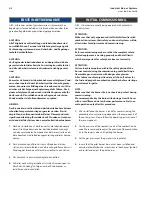
Industrial Burner Systems
7/8
www.ibs-brenner.de
erSte InBetrIeBnaHme
5. Nunmehr wird der Brenner wie folgt gestartet:
a.
Es ist sicherzustellen, daß alle Absperrventile geschlossen
sind und daß sich das Luftregelventil bzw. die Luftregelklappe
in der Startstellung (Minimum) befindet
b.
Starten des Verbrennungsluftventilators
c.
Es ist sicherzustellen, daß der Gasabsperrhahn und die
Sicherheitsmagnetventile des Zündbrenners geschlossen
sind
d.
Der Luftabsperrhahn des Zündbrenners ist vollständig zu
öffnen
e.
Der Gasabsperrhahn des Zündbrenners und des Haupt-
brenners ist zu öffnen
f.
Der Zündtransformator wird durch Start des Gasfeuerungs-
automaten aktiviert. Die automatischen Sicherheitsabsperr-
ventile des Zündbrenners werden vom Feuerungsautomaten
geöffnet und der Zündbrenner zündet.
g.
Nach erfolgreichem Start des Zündbrenners werden die
automatischen Sicherheitsventile des Hauptbrenners vom
Feuerungsautomaten geöffnet.
h.
Nach erfolgreichem Start des Hauptbrenners wird der Zünd-
brenner vom Feuerungsautomaten abgeschaltet.
6. Nachdem alle Brenner gestartet sind kann die Verbrennungs-
luftzufuhr bis zur Maximalposition erhöht werden
(entsprechend der maximalen Brennerleistung).
7. Nachdem die maximale Verbrennungsluftmenge eingestellt
wurde, ist die Gasmenge für die maximale Brennerleistung
einzustellen.
8. Die eingestellten Gas- und Luftmengen sind mittels Mess-
blenden zu überprüfen. Anstelle einer Messblende kann
der statische Luftdruck am Brennergehäuse zur Beurteilung
der Brennereinstellung herangezogen werden.
9. Der Brenner ist nunmehr in Kleinlast zu fahren und die
Beständigkeit des Regelverhältnisses zu überprüfen. Die
Schritte 6 bis 9 sind zu wiederholen bis die Einstellungen
korrekt und reproduzierbar sind.
10. Um die korrekte Brennereinstellung zu überprüfen ist eine
Abgasanalyse in Gross- und Kleinstellung des Brenners
durchzuführen.
11. Falls notwendig das System in den Automatikbetrieb versetzen.
12. Abstellen des Brenners:
a.
Kleinstellung anfahren
b.
Alle Brennstoffventile schließen
c.
Den Ventilator nicht abstellen bevor der Feuerungsraum eine
Temperatur von 400°C erreicht hat
InItIal COmmISSIOnInG
5. Now start the burner as follows:
a. Make sure that all shut-off valves are closed and that the
air control valve resp. the air control butterfly valve are in
start position (minimum).
b. Start the combustion air fan.
c. Make sure that the gas shut-off valve and the safety sole-
noid valves of the pilot burner are closed.
d. Completely open the air shut-off valve of the pilot burner.
e. Open the gas shut-off valve of the pilot burner and of the
main burner.
f. By starting the automatic burner control unit the ignition
transformer will be activated. The automatic safety shut-off
valves of the pilot burner will be opened by the automatic
burner control and the pilot burner ignites.
g. After successful start of the pilot burner the automatic bur-
ner control will open the automatic safety shut-off valves
of the main burner.
h. After successful start of the main burner the automatic
burner control will switch-off the pilot burner.
6. After having started all burners the combustion air inlet can
be increased up to the maximum position (according to the
maximum burner capacity).
7. After having set the maximum combustion air quantity,
adjust the quantity of gas for the maximum burner perfor-
mance.
8. Check the set quantities of gas and air by means of measu-
ring orifices. Instead of a measuring orifice, also the static air
pressure at the burner housing could be a basis to assess the
burner settings.
9. Run the burner now in low fire and verify if the settings are
stable. Repeat step 6 – 9 until the settings are correct and
reproducible.
10. Analyze the exhaust gas in high and low fire setting of the
burner in order to check the correct burner settings.
11. If required, put the system into automatic operation.
12. Shut down of the burner:
a. Return burner to low fire position
b. Close all fuel valves
c. Do not switch-off the fan before the combustion
chamber cooled down to 400 °C.


























